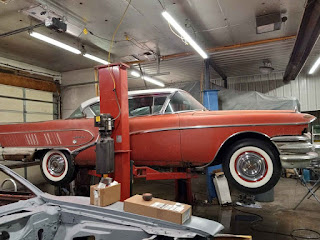There are few '50's cars I'd reserve a space for in my "Jay Leno Fantasy Garage" and this 1958 Buick Limited is not one of them. Sheesh, this thing is like a cheesy, '50's sci-fi movie; I can't not look at it. Pass the popcorn and Jujubes before I get bored and move onto something else.
Perhaps it wouldn't be so bad if the canvas this lay on wasn't so damn big. I mean, look at how much real estate is aft of the rear wheel here. At 227.5-inches long and a 79.8-inches wide, this is right up there with the some of the largest Yank Tanks ever manufactured. For the record, at 252.2-inches, the 1974-1976 Cadillac Fleetwood 75 is the longest vehicle every factory-produced for sale in this country. What's that you say? The '74 Fleetwood 75 was a limousine? Ok, Captain Details. Then as far as the longest conventional car goes, at 235.5-inches long, that trophy goes to Chrysler's 1973 Imperial LeBaron.
In comparison, the car that technically inspired this juggernaut of this wonton excess, Chrysler's 1957 Plymouth and Dodge models, at 204.6 inches long, look positively athletic. And few would say those cars are svelte. Better looking '57 Chevrolet's perhaps but skinny? No. By the way, Chevrolet's seminal 1957 models, of which a space for a black-on-red Bel Air is waiting in my garage, are puny runts at just 200-inches long.
So, what happened to cars in the 1950's? Why'd they get so big and so quickly? Especially those from my beloved General Motor's styling studios headed by Harley Earl? Good question. Seems that after a bevy of expensive engineering innovation, to maintain mid-1950's profit margins, rather than continue to innovate, they found it far more cost effective to simply add girth and tack on gimmicks.
The legend or story behind this car and other freakish GM designs of this era, with perhaps the exception of the 1958 Chevrolet, was GM executives upchucked their liquid lunches when they got a hold of Chrysler's new-for-'57 "forward look" models. Just-like-that, they scrapped their plans for 1958 and 1959 coming with some of the most, dare I say, ridiculous looking automobiles of all time. While the "1959 Cadillac" is unquestionably the most famous of the era, the shaft-of-the-spear of that late '50's GM design axiom were their barge-like Buick's. Oldsmobile's a very close second.
Buick had used the "Limited" moniker to denote their top-of-the-line models from 1936-1942 and they dusted it off for these one-year only brutes, sorry, ahem, beauties to commemorate their 50th-Anniversary. What made a "Limited" a "Limited" and made it more valuable or desirable than a run-of-the-mill Roadmaster? Nothing more than it was larger than anything else they offered, but there wasn't anymore leg room since it rode on the same 127-inch long wheelbase the Roadmaster did. However, buyers did get more chrome, cush, and more ersatz baubles and bits. My parents were of the generation that went bananas for cars like this so to that degree, I get it. To some degree anyway. Back then, "more was really more."
At the end of the 1958 model-year, though, these cars tanked at the box office and for several reasons. First of all, timing. Just as Buick took the bed sheet off these things, the nastiest economic downtown since the Great Depression struck cratering sales of large, expensive luxury cars. Didn't help that Buick charged more for these "Limited's" than Cadillac charged for a Series 62. Last and certainly not least, they was just plain fugly. Your opinion may vary, see dealer for details. And while you're doing that, please get me another box of Jawbreakers.
Things got even nuttier at Buick for 1959 at Buick before Harley Earl retired and the cool, refined hand of Bill Mitchell took over lending his vision to create some of the best looking designs of all time. Funny how we have to push the envelope of good and bad taste to learn from our mistakes.
Asking price for our '58 here is $10,000 which can buy a lot of movie theater popcorn. Please ask for a double serving of "butter-like-topping".







No comments:
Post a Comment